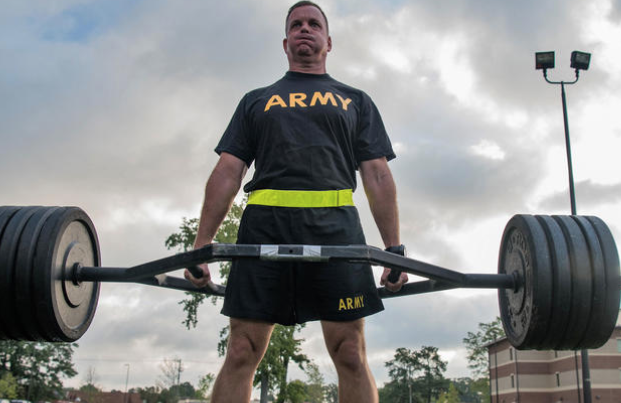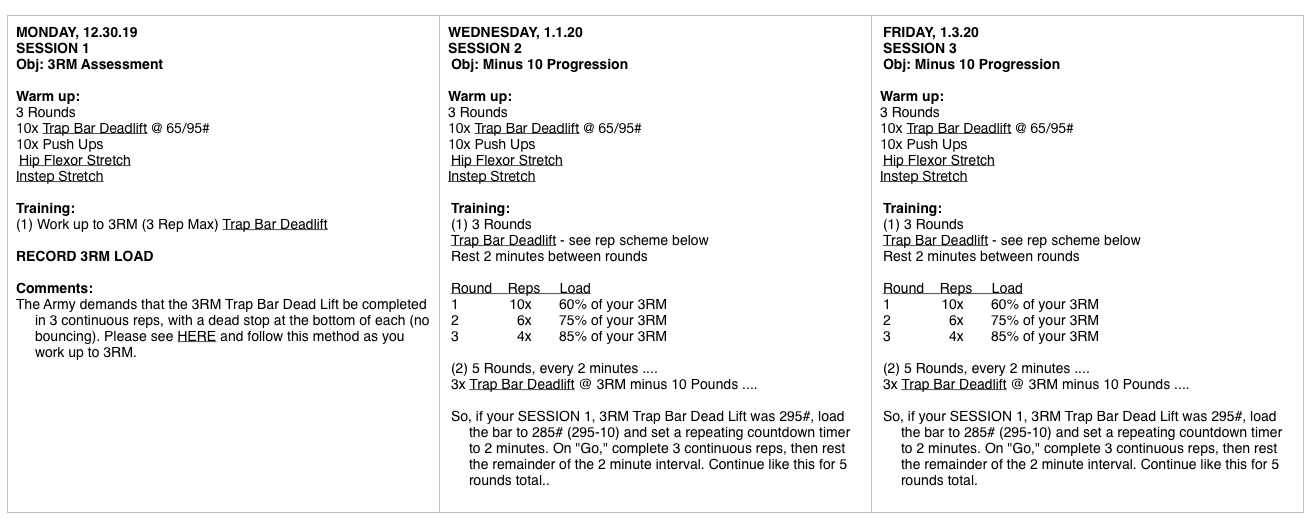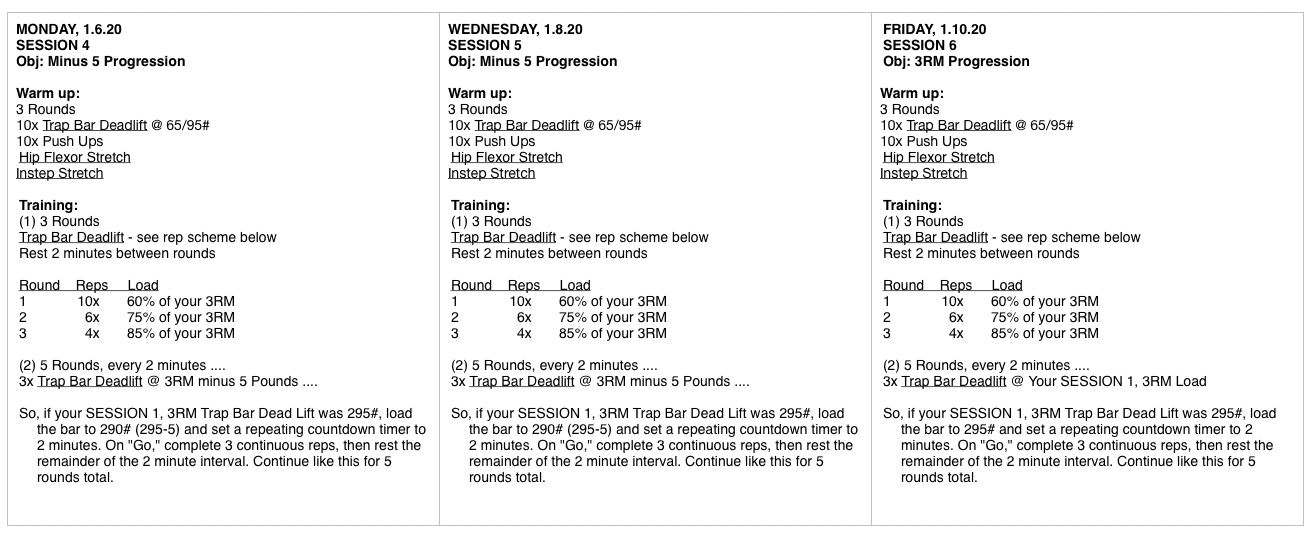By Rob Shaul, Founder
BLUF
We conducted a 3.5-week Mini-Study using remote lab rats to test the effectiveness of a hybrid Big 24/Density progression to increase 3RM (3 Repetition Max) Trap Bar Deadlift Strength.
Study participants saw an average 9.58% gain in 3RM Trap Bar Dead Lift strength over the course of the study period.
BACKGROUND
The Trap Bar Deadlift is a key event of the US Army’s proposed new Army Combat Fitness Test (ACFT) as well as new British Army fitness tests. If the US Army fully adopts the ACFT, it’s possible the 3RM Trap Bar Deadlift will be adopted by more military services for both line unit and military course/selection fitness tests.
One of the issues with this event is limited equipment to train with. The goal of this study was to test a super-efficient and easy to implement strength progression for strength gain effectiveness.
The progression tested was a “hybrid” of MTI’s Big 24 and Density progression methodologies. Big 24 Progression specifically develops 3RM Strength and for the working sets, and is not percentage-based – making working loads and progressions easy and quick to calculate.
Density progression simply applies a time limit in which the heavy, working sets must be completed.
In our in-house testing, we’ve been able to have three athletes, with different working loads use the same barbell for their working sets within the Density time limit. Given the limited equipment (barbells/plates) we suspect many military members will have to deal with while training this exercise, having three soldiers per barbell is a clear benefit.
Past research has proven the effectiveness of the Big 24 Progression. The difference for the progression tested in this study was adding the Density component – a 2-minute time limit for the 5 heavy working sets. We have never tested this hybrid progression in our Wyoming facility and we were unsure if athletes, especially strong athletes, would be able to complete the progression without modification.
These were the study questions:
- Would subjects be able to complete the hybrid Big 24/Density Progression as prescribed?
- Would the hybrid Big 24/Density Progression increase Trap Bar 3RM strength and if so, how much?
MINI-STUDY DESIGN/DEPLOYMENT
A 3.5-week cycle was designed to test the study progression above, and MTI advertised for Lab Rats via our weekly newsletter, Beta, which has 30,000+ weekly subscribers.
Lab Rat volunteers verified they had access to Trap Bars, weight, and could dedicate 3.5 weeks to this study. All completed the same programming and began their cycles with a Monday 3RM Trap Bar Deadlift Assessment, which was repeated after three weeks of 3-day/week training using the appropriate progression.
The Study was completed in the December 2019 – January 2020 time frame, and the study subjects self-reported their pre and post cycle assessment results.
Each Group completed a total of 10 Trap Bar Deadlift training sessions on top of their regular programming. These included the two pre and post-study 1RM assessments.
The Mini-Study was designed to complement the athletes’ regular training. We asked participants to avoid all other deadlifting during the study duration.
Below is the progression outline/details:
RESULTS AND DISCUSSION
A total of 36 experienced training and weight lifting individuals with an average age of 35.8 completed the study. The average gain in 3RM Trap Bar Deadlift strength was 9.58 percent.
Below are the individual and overall results.
Study design elements that could have impacted these results could include it’s a relatively short duration (3.5 weeks), and how other training may have impacted trap bar deadlift performance.
By design, this study didn’t dictate the athlete’s full training regimen during the study period as we wanted to test the ability to study a focused fitness attribute change without dictating complete programming. This was done to encourage lab rat participation and decrease attrition.
Going in, we had two research questions:
(1) Would subjects be able to complete the hybrid Big 24/Density Progression as prescribed?
Just two athletes reported they were unable to complete the prescribed working rep count in the 2-minute density time limit. They were instructed to decrease reps as needed – not load – and continue with the progression. Overall, the vast majority of the athletes were able to complete the program as prescribed, including load, reps and time limit.
(2) Would the hybrid Big 24/Density Progression increase Trap Bar 3RM strength and if so, how much?
We were pleasantly surprised by the 9.58% average increase in 3RM strength from this mini-study, especially given the high training age/experience of the athletes tested.
NEXT STEPS
One of the issues facing the US Army and other services implementing a 3RM Trap Bar Deadlift as a fitness test event is the relative weightlifting inexperience of many soldiers taking the test and the resulting risk of injury. We assume this is why the Army has chosen the Trap Bar Deadlift as the ACFT strength event – given its more simple technique demands over the traditional deadlift, and fewer equipment requirements of the traditional back squat.
One suggestion for this study was to include one volume day of lighter weight/higher reps to help familiarize athletes with the exercise. However, by design we feel we’ve achieved this with the purposeful set/rep scheme of the warm up and part (1) of the programming above. With the exception of test days, athletes will have performed 50x trap bar deadlift reps before getting to their heavy, working rounds. Not only does this design help warm them up for the heavy load, but also provides plentiful exercise practice.
Next steps could include conducting the same study, but having athletes train the progression 2 times a week, vice three. Give the expected equipment limitations at many Army units, this could help give more soldiers access to the trap bar and plates.
MTI-specific, we intend to change the programming in our current ACFT training plan to match this hybrid Big 24/Density progression.
Much appreciation to the remote “Lab Rats” who participated in this study. Our remote lab rat program allows us to test more programming, more frequently, and thus further accelerate MTI’s programming evolution and improvement.
Questions,Feedback,Comments? Email rob@mtntactical.com
STAY UPDATED
Sign-up for our BETA newsletter. Training tips, research updates, videos and articles - and we’ll never sell your info.





